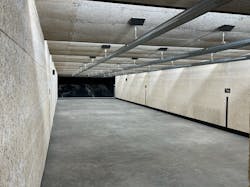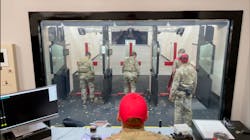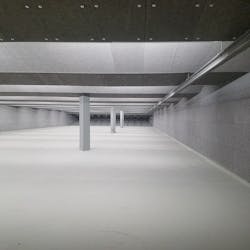Indoor Range Design Considerations
The most basic concern with any range is obviously controlling the projectiles. Outdoor ranges, no matter how well designed, always have a higher chance of rounds escaping the intended confines of the range. Most readers are aware of just how far bullets can travel and why there’s so much safe space around ranges required. With indoor ranges, the chances of rounds escaping are greatly reduced, although not zero. Once you get past the obvious priority concern of containing dangerous projectiles, other health and safety considerations have to be addressed as well: ventilation, sound and containment of biohazard material such as unburnt propellants, carbon, lead and more.
Something we learned from Mr. Bergiadis is that the acoustic materials used to contain the noise within the range are also designed to reduce the sound and reduce blast overpressure (that thump you feel when firing a round off as the air pressure in the vicinity of the fired weapon increases briefly). The materials used cannot trap gunpowder/propellants and cannot support combustion.Anyone who has shot enough on a range has experienced ricochets and splatter. The acoustic materials used inside a range are also expected to minimize ricochets and splatter and are usually used in conjunction with multiple layers of plywood over steel to contain such. The Troy Acoustics materials have been approved for use without the plywood, reducing the cost of construction and space lost to multiple layers of construction materials.
Two things we hadn’t really thought about prior to interviewing Mr. Bergiadis focus on what they called echo or reverb. Inside of a common range, the sound from each shot can echo for as much as six to nine seconds depending on the size of the range. That is a concern for each shooter but it’s an ever larger concern for the range personnel who have to be in it for 8-plus hours each day. Further, the blast overpressure, described above, becomes a health concern for the instructors who have to work exposed to it for an 8-plus hour shift each work day.
Properly incorporated acoustic materials will reduce the felt blast overpressure and minimize the echo or reverb. Troy Acoustics material, as the example, is guaranteed to reduce echo so that it lasts not more than 1.3 seconds. Depending on the range itself, that’s a reduction of 75-85%.
We also spoke with Denny Boles and Greg Read from Brinkley Sargent Wiginton Architects, who are experienced in designing indoor ranges. Specifically addressing sound exposure, they stated that NIOSH (National Institute for Occupational Safety & Health) recommendations for audio (sound) exposure is a maximum of 85dB (decibels) weighted over an 8 hour period. They further specify that momentary exposure over 140dB should be avoided. To put that in perspective, the most common calibers used by law enforcement are 9mm, .40S&W, .45ACP, 5.56mm and 7.62mm. They generate sound levels (per shot) between 155dB and 172dB. The range design and acoustics material incorporated have to reduce those sound levels down to below 140dB in the momentary exposure and below 85dB across the span of a day’s training. This is, of course, accomplished in combination with proper hearing protection worn by the shooters and range staff.BSW Architects expanded on the range design concerns for indoor ranges to discuss not only the sound deadening/reverb dampening requirements but also the concerns and limits on ventilation, projectile containment, biohazard containment, lighting, target control and storage. All of those issues/challenges have to be dealt with as part of the design from the ground up but all have to be balanced by the surroundings and environment. The needs and requirements, as balanced against surroundings can change depending on whether the range is placed in a residential, commercial or industrial area. Prior to designing the structure, the site selection along with the needs and requirements of the agency have to all be clearly identified. A list or description of the area and structures adjacent to the range facility has to be made.
Interestingly, while interviewing Mr. Boles from BSW Architects, we learned that the building design isn’t all about health safety but also about caring for the environment around the intended facility as well. BSW Architects works with such organizations as Leadership in Energy & Environmental Design (LEED) and the US Green Building Council (USGBC). They design indoor ranges that aren’t only safe for the shooters and staff who use them but also minimize any impact on the surrounding environment.
As you can see from all of the above, simply deciding you need a range is the barest of beginnings. There is a lot to be considered from needs and requirements to location to materials. It’s a good idea to start out with guidance from those already experienced in the business.
About the Author
Lt. Frank Borelli (ret), Editorial Director
Editorial Director
Lt. Frank Borelli is the Editorial Director for the Officer Media Group. Frank brings 20+ years of writing and editing experience in addition to 40 years of law enforcement operations, administration and training experience to the team.
Frank has had numerous books published which are available on Amazon.com, BarnesAndNoble.com, and other major retail outlets.
If you have any comments or questions, you can contact him via email at [email protected].





